Animals
Discover Animals that Start with L – Explore & Learn
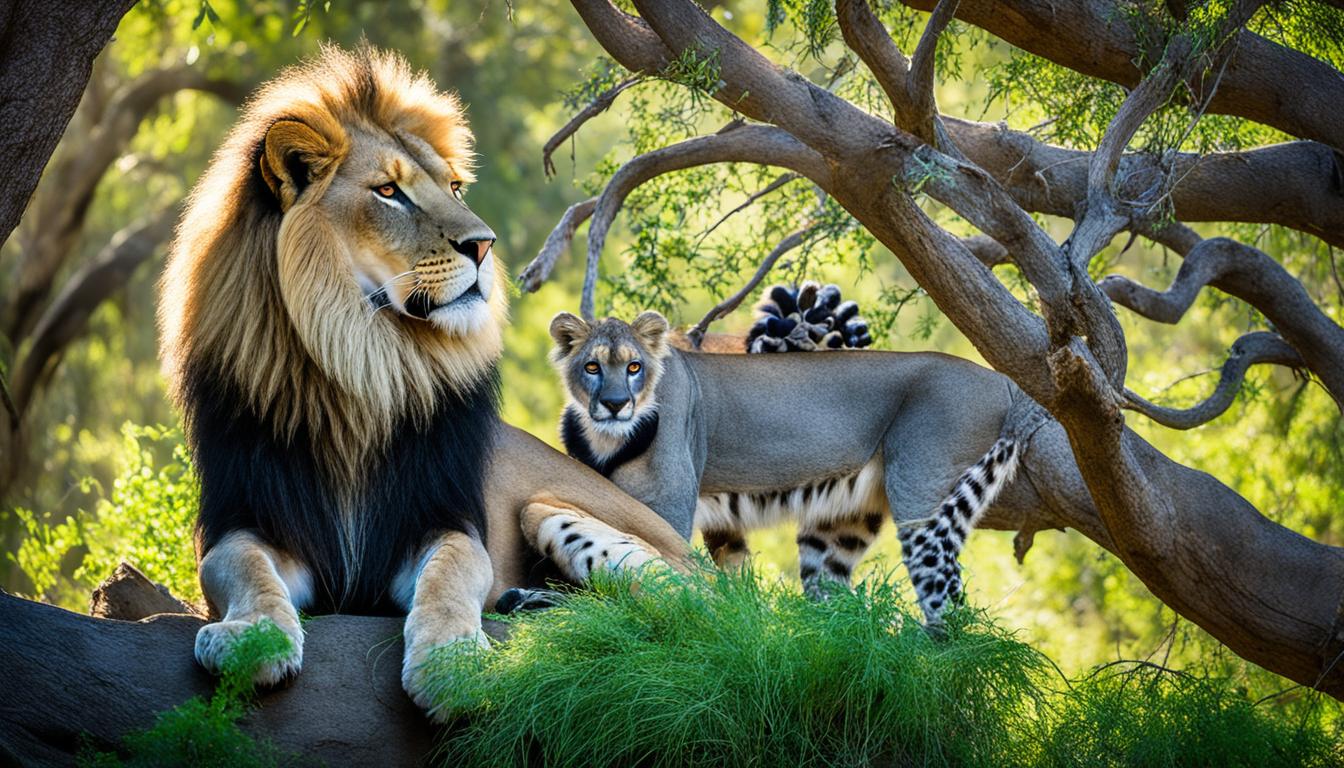
Did you know that there are numerous animals that start with L, both on land and in water? From majestic beasts to fascinating marine creatures, the animal kingdom is full of diverse and captivating species that begin with this letter. In this article, we will take a closer look at some of these remarkable creatures and delve into their unique characteristics and habitats.
Key Takeaways:
- There are numerous animals that start with L, including lions, lobsters, leopards, and more.
- Lions are often referred to as the kings of the animal kingdom due to their majestic appearance and dominant nature.
- Lobsters are fascinating marine creatures with a long lifespan, known for their ability to live up to 100 years.
- Leopards are beautiful and adaptable hunters that can be found in various habitats, including forests and grasslands.
- The lyrebird is an Australian native bird known for its unique song and ability to mimic various sounds.
Lions
In the animal kingdom, lions are often referred to as the kings, and it’s not hard to see why. With their majestic appearance and dominant nature, they command respect and admiration. Male lions, in particular, are easily recognizable thanks to their golden-colored fur and impressive manes. These regal creatures live in prides, forming strong social bonds with other members.
As carnivores, lions primarily feed on large ungulates such as zebras and wildebeests. Their powerful bodies and sharp teeth make them formidable hunters, playing a crucial role in maintaining the balance of ecosystems. Lions are known for their incredible strength and agility, which they rely on during hunts and territorial disputes.
Unfortunately, the lion population has faced significant declines in recent years, primarily due to habitat loss, poaching, and conflicts with humans. As a result, conservation efforts are crucial to ensure the long-term survival of these iconic animals. By protecting their habitats and implementing sustainable practices, we can help preserve the kings of the animal kingdom for future generations.
“The only way to save a rhinoceros is to save the environment in which it lives, because there’s a mutual dependency between it and millions of other species of both animals and plants.” – David Attenborough
Amazing Facts about Lions
- Lions are the second-largest big cat species in the world, surpassed only by tigers.
- Female lions, or lionesses, are the primary hunters in the pride, working together to bring down prey.
- A lion’s roar can be heard up to 5 miles away, serving as a powerful communication tool.
- Lions are known for their social structure, with prides often consisting of related females and their offspring, led by a dominant male.
- The conservation status of lions is listed as vulnerable, highlighting the urgent need for conservation efforts to protect these magnificent creatures.
Lions vs. Other Big Cats: A Comparison
| Species | Average Weight (Male) | Habitat | Primary Prey | Conservation Status |
|---|---|---|---|---|
| Lion | 330 to 500 pounds | Grasslands, savannas | Ungulates (zebras, wildebeests) | Vulnerable |
| Tiger | 400 to 700 pounds | Forests, grasslands, mangroves | Deer, boar, water buffalo | Endangered |
| Jaguar | 100 to 250 pounds | Forests, swamps, grasslands | Capybara, peccary, deer | Near Threatened |
Lobsters
Lobsters are interesting marine creatures that start with L. They have jointed legs and a hard exoskeleton, similar to insects. Lobsters are known for their ability to live for a long time, with some individuals reaching an age of up to 100 years. They mainly feed on algae, shrimp, and other small marine organisms. Lobsters are also popular seafood and are widely enjoyed by people around the world.
| Key Features | Habitat | Lifespan |
|---|---|---|
| Jointed legs and hard exoskeleton | Ocean floor, coastal areas | Up to 100 years |
Lobsters have several key features that contribute to their unique characteristics. Their jointed legs and hard exoskeleton enable them to navigate the ocean floor and coastal areas with agility and protection. They are well adapted to their habitat and play an important role in the marine ecosystem.
One of the most fascinating aspects of lobsters is their long lifespan. Unlike many other marine creatures, lobsters have the potential to live for an exceptionally long time. Some individuals have been documented to reach up to 100 years, making them one of the longest-living creatures on Earth.
“Lobsters have a unique ability to live for a long time, with some individuals reaching an impressive age of up to 100 years.”
Lobsters primarily feed on algae, shrimp, and other small marine organisms. Their diet contributes to their growth and overall health. They are also known for their distinctively delicious taste, which has made them a popular seafood choice worldwide.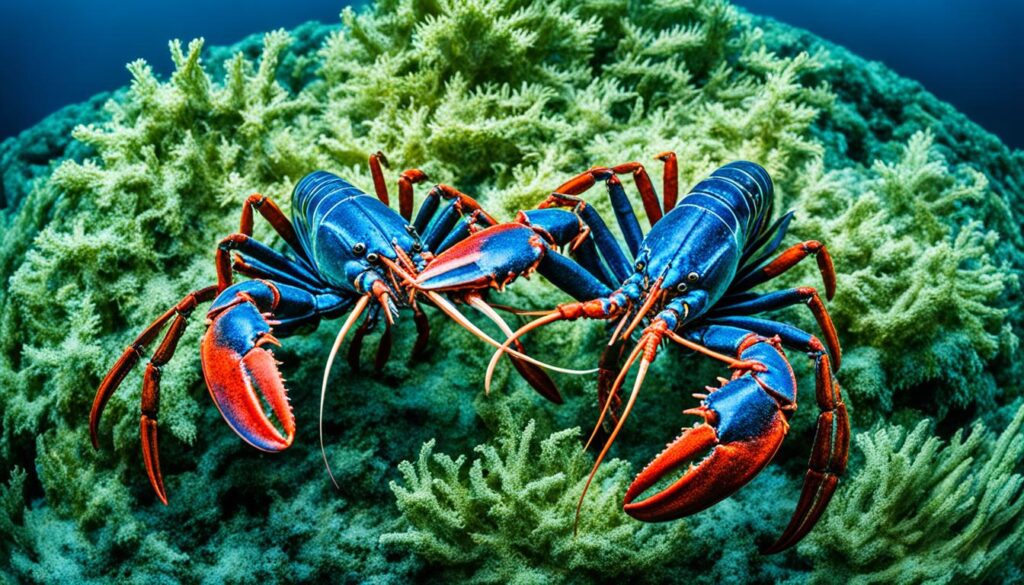
Overall, lobsters are fascinating marine creatures that captivate the attention of both scientists and seafood enthusiasts. Their jointed legs, hard exoskeleton, and long lifespan make them truly unique in the animal kingdom.
Leopards
Leopards are beautiful and adaptable animals that start with L. They have a slender body, short legs, and distinctive spots on their fur. Leopards are skilled climbers and are known to be excellent hunters. They can be found in various habitats, including forests and grasslands. Leopards primarily prey on medium-sized animals such as deer, but they are also known to consume smaller prey like reptiles and birds.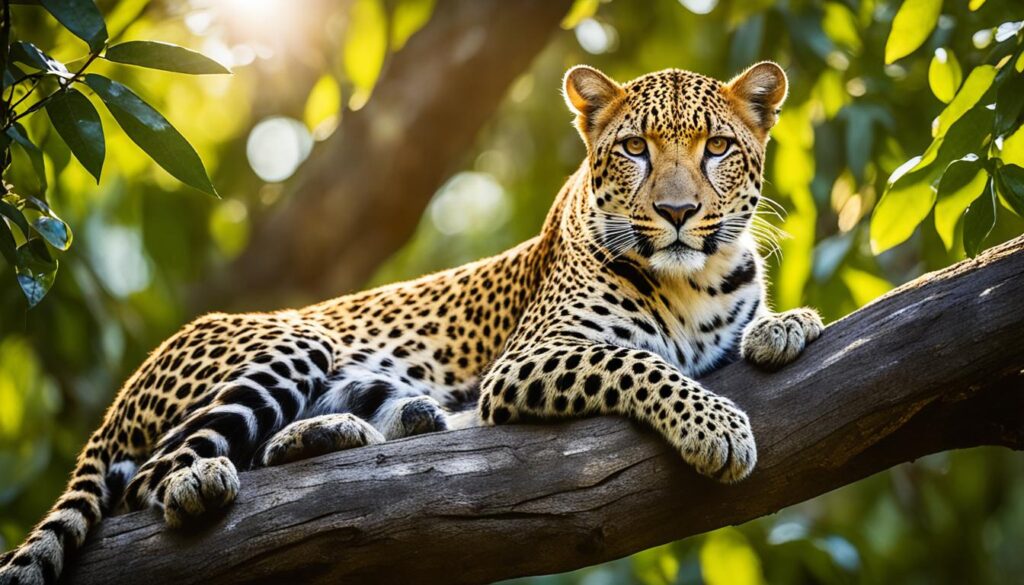
Leopards are remarkable creatures that have the ability to thrive in diverse habitats. Their adaptability allows them to hunt and survive in different environments, making them versatile predators. Whether navigating through dense forests or stalking their prey on the open savannah, leopards demonstrate incredible agility and stealth.
These solitary hunters possess exceptional camouflage with their spotted fur, which helps them blend seamlessly into their surroundings. The leopard’s spots not only provide visual appeal but also aid in their hunting techniques by making them less visible to potential prey.
“The leopard is a predator perfectly adapted to its environment, with a combination of strength, agility, and adaptability that allows it to successfully hunt in diverse habitats.”
In addition to their incredible hunting skills and adaptability, leopards also showcase a wide range of behaviors. They are known for their ability to climb trees, enabling them to escape from predators, rest, and stash their kill out of reach from scavengers. This unique trait sets them apart from other big cats and adds to their versatility as adaptable predators.
Leopard Habitat
Leopards have diverse habitats, ranging from sub-Saharan Africa to the forests of the Russian Far East. They are remarkably adaptable and can thrive in various ecosystems, including rainforests, mountains, deserts, and grasslands. This adaptability is a testament to their ability to exploit different environments and find success in a variety of settings.
The diverse habitats leopards inhabit also contribute to their survival and conservation efforts. These ecosystems provide the necessary resources, such as prey availability and suitable shelter, for leopards to thrive. However, habitat loss and fragmentation pose significant threats to these majestic animals, making conservation efforts crucial to their long-term survival.
Leopards as Apex Predators
Leopards are considered apex predators within their ecosystems, playing a vital role in maintaining the balance of nature. As efficient hunters, they regulate prey populations, preventing overgrazing and helping to maintain healthy ecosystems. By controlling the herbivore populations, leopards indirectly impact vegetation and influence the overall biodiversity of their habitats.
The adaptability, hunting prowess, and diverse habitats of leopards make them an extraordinary species to study and admire. Their presence in the wild signifies the resilience and interconnectedness of our natural world.
Lyrebird
The lyrebird is an interesting bird species that starts with L. It is native to Australia and is known for its remarkable song. Male lyrebirds have an elaborate song that incorporates elements from various other bird species, making it a unique vocal performance. These birds are also known for their ability to mimic a wide range of sounds, including human voices and machinery.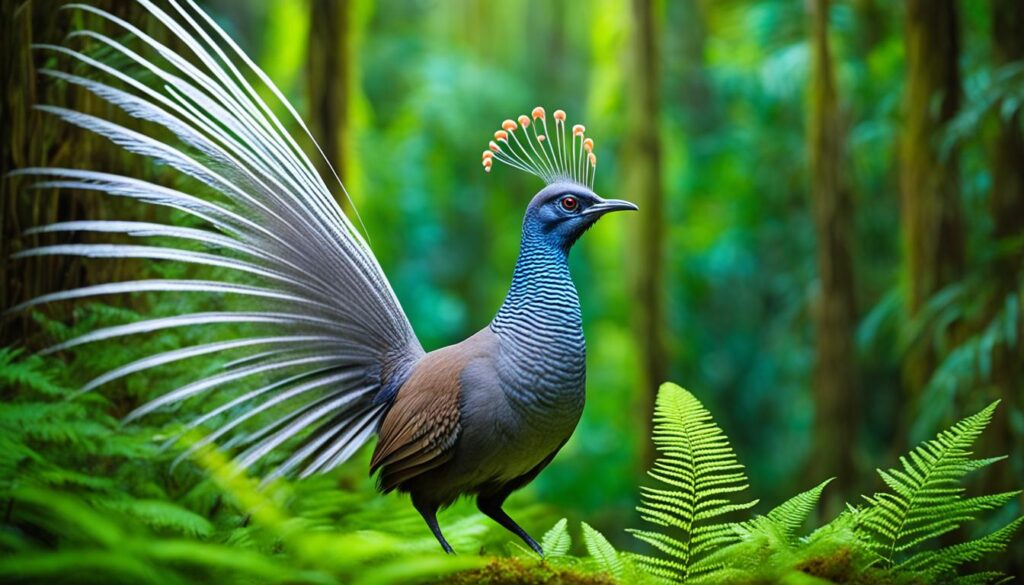
The lyrebird’s ability to mimic sounds is so impressive that it can often be mistaken for other birds or even non-avian sounds. This behavior plays an important role in their mating rituals and territorial defense. Male lyrebirds use their vocal abilities to attract females and establish their dominance over other males. It’s a fascinating display of nature’s diversity and the incredible adaptability of these Australian native birds.
Lamprey Fish
Lamprey fish are intriguing creatures that start with L. They are known for their parasitic nature, as they attach themselves to other fish and feed on their blood. Lampreys resemble eels and can be found in both freshwater and saltwater environments.
They have a unique feeding mechanism that involves using their round mouths filled with sharp teeth to latch onto their prey. Despite their somewhat gruesome feeding habits, lampreys play an important role in aquatic ecosystems.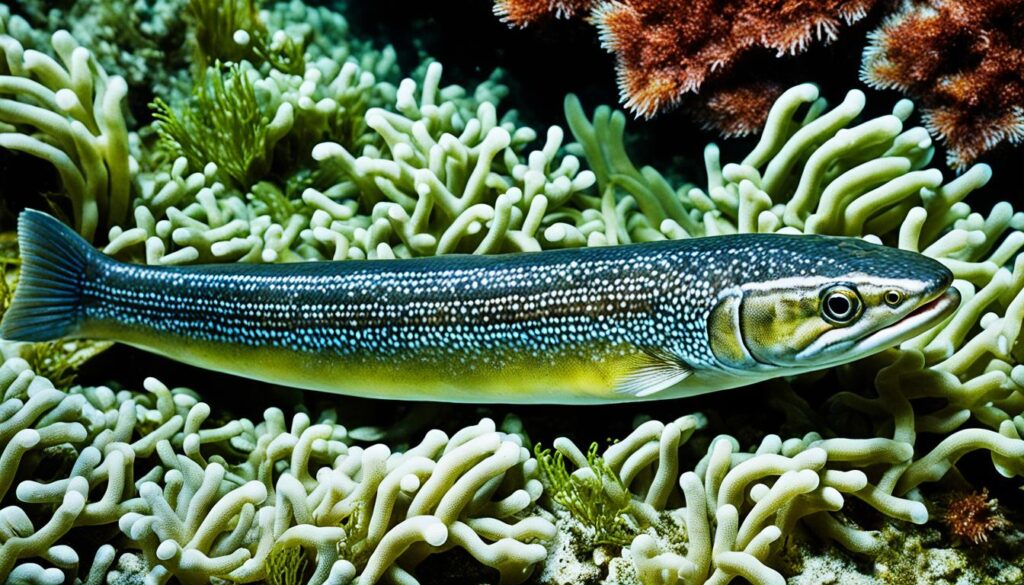
The Parasitic Nature of Lamprey Fish
Lamprey fish are notorious for their parasitic nature. They have the ability to attach themselves to other fish using their suction-cup-like mouth and feed on their blood. This parasitic feeding behavior can have detrimental effects on the host fish, as it weakens them and can lead to their eventual death.
“Lampreys are fascinating creatures with a unique feeding mechanism. They attach themselves to other fish and feed on their blood, playing a crucial role in the delicate balance of aquatic ecosystems.” – Marine Biologist, Dr. Emily Collins
The Unique Feeding Mechanism of Lamprey Fish
The feeding mechanism of lamprey fish is truly remarkable. They have round mouths filled with sharp, needle-like teeth that allow them to latch onto their prey. Once attached, they use their teeth to create a small hole in the fish’s skin and feed on its blood. This unique adaptation enables lampreys to survive and thrive in their aquatic environments.
The Role of Lamprey Fish in Aquatic Ecosystems
Although lamprey fish are often seen as parasites, they actually play an important role in aquatic ecosystems. By feeding on weak or diseased fish, they help to maintain the overall health and balance of the ecosystem. Lampreys also serve as a food source for other predators, contributing to the intricate web of life in rivers, lakes, and oceans.
| Key Facts about Lamprey Fish | |
|---|---|
| Common Name | Lamprey fish |
| Scientific Name | Petromyzontidae |
| Habitat | Freshwater and saltwater environments |
| Feeding Behavior | Parasitic, feed on the blood of other fish |
| Physical Characteristics | Resemble eels, round mouth with sharp teeth |
Lion’s Mane Fish
The lion’s mane fish is a fascinating creature that starts with L. It is the largest species of jellyfish in the world, with a bell that can be as wide as 7 feet and tentacles as long as 100 feet. The lion’s mane fish gets its name from its distinctive appearance, with an orange-colored bell and golden tentacles resembling a lion’s mane.
This majestic creature can be found in cooler regions of the Atlantic and Pacific oceans. While the lion’s mane fish may be large and poisonous, its young ones can still fall prey to sea turtles, giant fish, and other predators.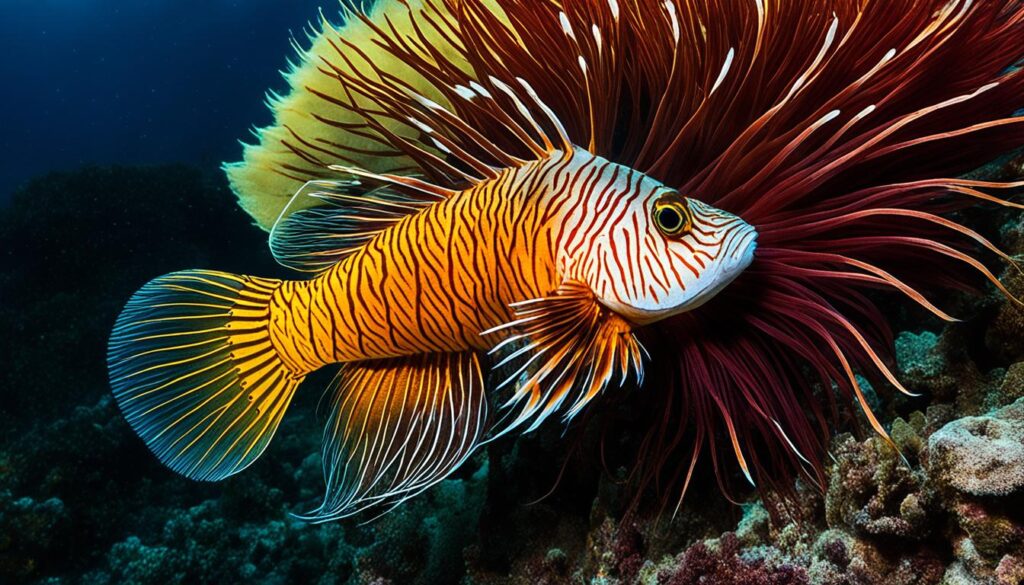
Although the lion’s mane fish may appear intimidating, it plays an important role in the ocean ecosystem. Its large size and abundant tentacles contribute to the diversity of marine life.
| Characteristics | Details |
|---|---|
| Size | The largest species of jellyfish, with a bell width up to 7 feet and tentacles as long as 100 feet. |
| Appearance | Distinctive orange-colored bell and golden tentacles resembling a lion’s mane. |
| Habitat | Found in cooler regions of the Atlantic and Pacific oceans. |
| Prey | Feeds on small fish, plankton, and other organisms. |
| Predators | Young lion’s mane fish can be preyed upon by sea turtles, giant fish, and other predators. |
| Importance | Contributes to the biodiversity of marine ecosystems. |
This unique and mesmerizing creature offers a glimpse into the wonders of the ocean and reminds us of the diverse and fascinating life forms that inhabit our planet.
Less Known Land Animals That Start With L
In addition to the well-known animals mentioned earlier, there are also lesser-known land animals that start with L. These include the lyrebird, a unique bird with an elaborate song, the lamprey fish, a fascinating fish with a parasitic nature, and the lion’s mane fish, a jellyfish with a distinctive appearance. Each of these animals has its own characteristics and habitats that make them intriguing to learn about.
Let’s take a closer look at these fascinating creatures:
Lyrebird
The lyrebird is a remarkable bird species native to Australia. What sets the lyrebird apart is its ability to mimic a wide range of sounds, including the songs of other bird species. Male lyrebirds have an elaborate song that incorporates elements from various other birds, making it a truly unique vocal performance. These birds are also known for their ability to mimic non-biological sounds, such as human voices and machinery.
Lamprey Fish
The lamprey fish is a fascinating creature found in both freshwater and saltwater environments. These jawless fish are known for their parasitic nature, as they attach themselves to other fish and feed on their blood. Lampreys have a round mouth filled with sharp teeth that they use to latch onto their prey. While their feeding habits may seem gruesome, lampreys play an important role in maintaining the balance of aquatic ecosystems.
Lion’s Mane Fish
The lion’s mane fish, also known as the lion’s mane jellyfish, is the largest species of jellyfish in the world. It gets its name from its distinctive appearance, with an orange-colored bell and long, golden tentacles resembling a lion’s mane. These jellyfish can grow up to 7 feet in width and have tentacles as long as 100 feet. While they are large and can deliver painful stings, their young ones can be preyed upon by sea turtles, giant fish, and other predators. Lion’s mane jellyfish are typically found in cooler regions of the Atlantic and Pacific oceans.
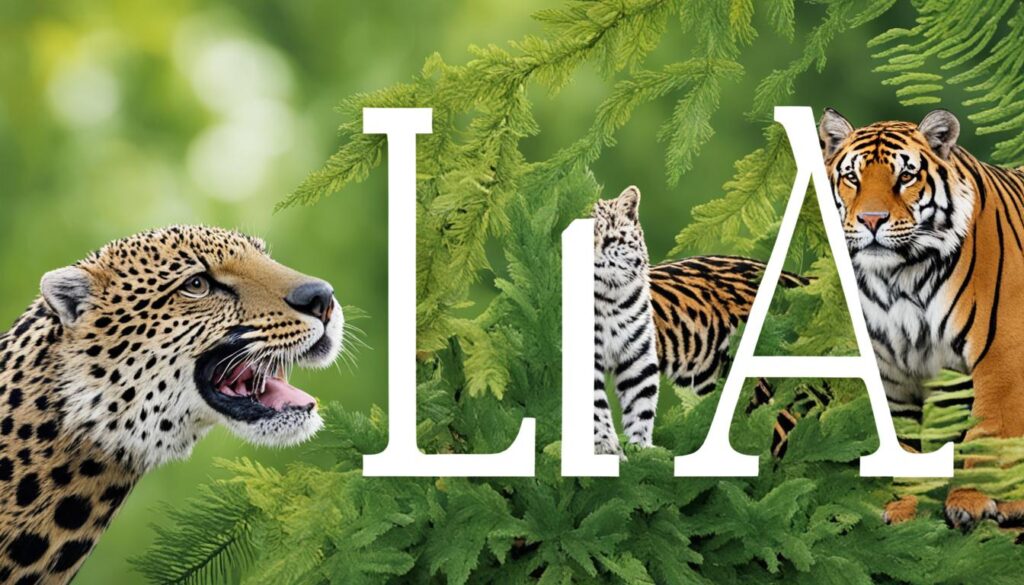
| Animal | Description |
|---|---|
| Lyrebird | A bird native to Australia known for its ability to mimic various sounds, including the songs of other bird species. |
| Lamprey Fish | A parasitic fish that attaches itself to other fish and feeds on their blood, playing a crucial role in aquatic ecosystems. |
| Lion’s Mane Fish | The largest species of jellyfish in the world, with an orange-colored bell and long, golden tentacles resembling a lion’s mane. |
Well-known Animals That Start With L
Lions, lobsters, and leopards are among the well-known animals that start with L. These creatures capture our imagination with their unique characteristics and play significant roles in their respective habitats.
Lions
Lions are iconic creatures known for their regal presence and majestic appearance. As kings of the animal kingdom, they command respect and admiration. With their golden-colored fur and distinctive manes, male lions are easily recognizable. They live in prides, social groups that consist of related females and their offspring. Lions are primarily found in savannas and grasslands, where they rely on their strength and teamwork to hunt large ungulates such as zebras and wildebeests.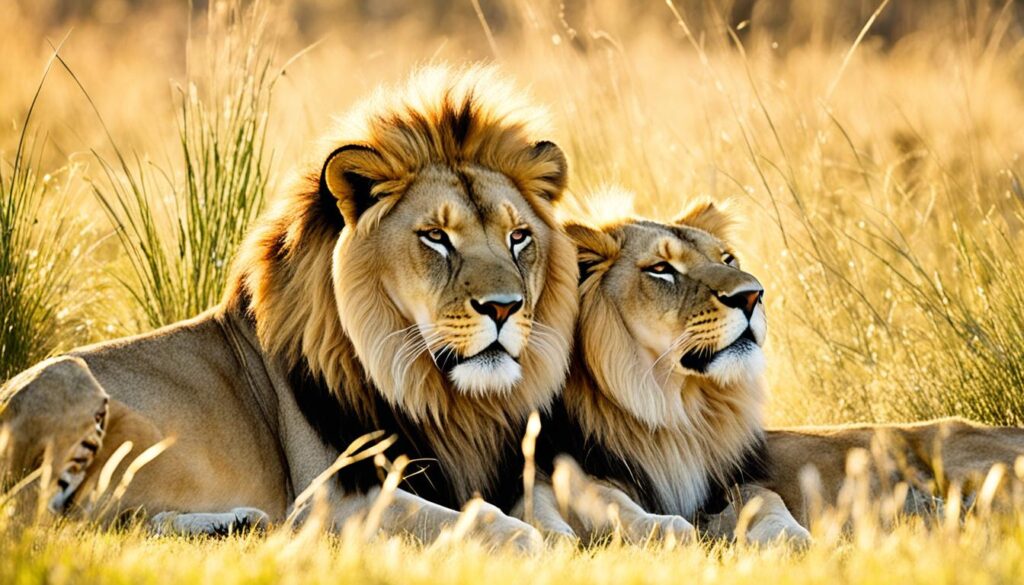
Lobsters
Lobsters are fascinating marine creatures with a long lifespan. They are known for their hard exoskeleton, jointed legs, and distinctive claws. Lobsters inhabit coastal waters and are often found in rocky areas. They have an important role in the marine ecosystem as scavengers and predators, feeding on a variety of small organisms such as shrimp, fish, and even other lobsters. Lobsters are not only important for ecological balance but also highly valued as seafood, enjoyed by people around the world.
Leopards
Leopards are beautiful and adaptable hunters that can thrive in various habitats, including forests, grasslands, and mountains. These spotted felines have a slender body, short legs, and a graceful gait. Leopards are skilled climbers and have even been observed dragging their prey up into trees for safekeeping. Their diet primarily consists of medium-sized prey such as deer and antelope, but they are also known to target smaller animals like birds and reptiles. Leopards are solitary animals and excellent at camouflage, blending seamlessly into their surroundings.
By learning about these well-known animals that start with L, we gain a deeper understanding of the natural world and the diverse creatures that inhabit it. From the powerful and majestic lions to the fascinating lobsters and the adaptable leopards, each of these animals showcases the wonders of nature and the incredible diversity of life on Earth.
Less Known Animals That Start With L
In addition to the well-known animals that start with L, there are also lesser-known creatures worth exploring. These fascinating and unique animals include the lyrebird, lamprey fish, and lion’s mane fish. Let’s take a closer look at each of these lesser-known species:
Lyrebird
The lyrebird is an intriguing bird species native to Australia. What sets the lyrebird apart is its impressive song, which incorporates elements from various other bird species. Known for its mimicry, the lyrebird can accurately replicate sounds such as other bird calls, human voices, and even machinery. This unique vocal performance makes the lyrebird a captivating creature to study and appreciate.
Lamprey Fish
The lamprey fish is an aquatic species that exhibits a fascinating parasitic nature. Found in both freshwater and saltwater environments, the lamprey fish has a distinctive appearance resembling an eel. What makes this fish truly remarkable is its feeding mechanism. With a round mouth filled with sharp teeth, the lamprey fish latches onto other fish and feeds on their blood. While their feeding habits may seem gruesome, lamprey fish play a crucial role in maintaining balance in aquatic ecosystems.
Lion’s Mane Fish
The lion’s mane fish is one of the largest jellyfish species found in the world’s oceans. With a bell that can reach up to 7 feet in diameter and tentacles as long as 100 feet, the lion’s mane fish is a striking sight. This jellyfish gets its name from its appearance, with an orange-colored bell and tentacles resembling a lion’s mane. While they are large and possess stinging cells, the young lion’s mane fish are preyed upon by sea turtles, giant fish, and other predators. The lion’s mane fish is mainly found in cooler regions of the Atlantic and Pacific oceans.
These lesser-known animals that start with L offer a fascinating glimpse into the diversity of life on our planet. From the lyrebird’s unique song to the lamprey fish’s unique feeding mechanism and the lion’s mane fish’s distinctive appearance, each of these creatures carries its own captivating traits that deserve recognition and appreciation.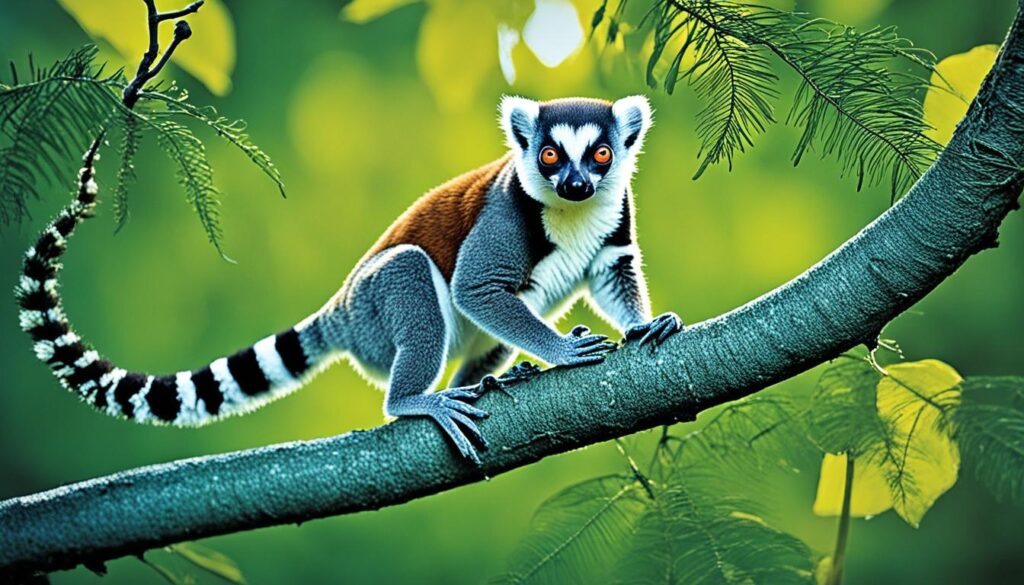
| Animal | Description |
|---|---|
| Lyrebird | An intriguing bird species native to Australia known for its unique song and ability to mimic various sounds. |
| Lamprey Fish | An aquatic species with a parasitic nature, attaching itself to other fish and feeding on their blood. |
| Lion’s Mane Fish | The largest jellyfish species in the world with a distinctive appearance resembling a lion’s mane. |
Land Animals That Start With L
When it comes to land animals, there are several fascinating creatures that start with the letter L. Let’s take a closer look at three of them: lions, leopards, and llamas.
Lions
Lions are majestic creatures known for their dominance and distinctive manes. These mighty animals are often referred to as the kings of the animal kingdom. With their golden-colored fur and powerful build, lions are truly a sight to behold. They live in prides, hunting together and establishing their reign over their territories. Lions primarily feed on large ungulates such as zebras and wildebeests. Unfortunately, these magnificent beasts have faced increasing threats and their population has significantly declined in recent years, making conservation efforts crucial for their survival.
Leopards
Leopards are agile climbers with beautiful spotted fur, making them masters of stealth and camouflage. These adaptable hunters are widely distributed across various habitats, including forests and grasslands. Leopards have the ability to adapt to different environments, making them skilled stalkers and hunters. They primarily prey on medium-sized animals such as deer, but they are also known to consume smaller prey like reptiles and birds. Their majestic appearance and incredible hunting abilities make them a true wonder of the animal kingdom.
Llamas
Llamas are domesticated animals that have been a part of human history for centuries. These gentle creatures are native to the Andes Mountains in South America and are highly valued for their wool, which is used to make various textiles. Llamas are also used for transportation in their native regions, carrying goods and supplies through the rugged terrain. Their friendly temperament and unique appearance, with long, shaggy coats and banana-shaped ears, make them popular attractions in zoos and farms around the world.
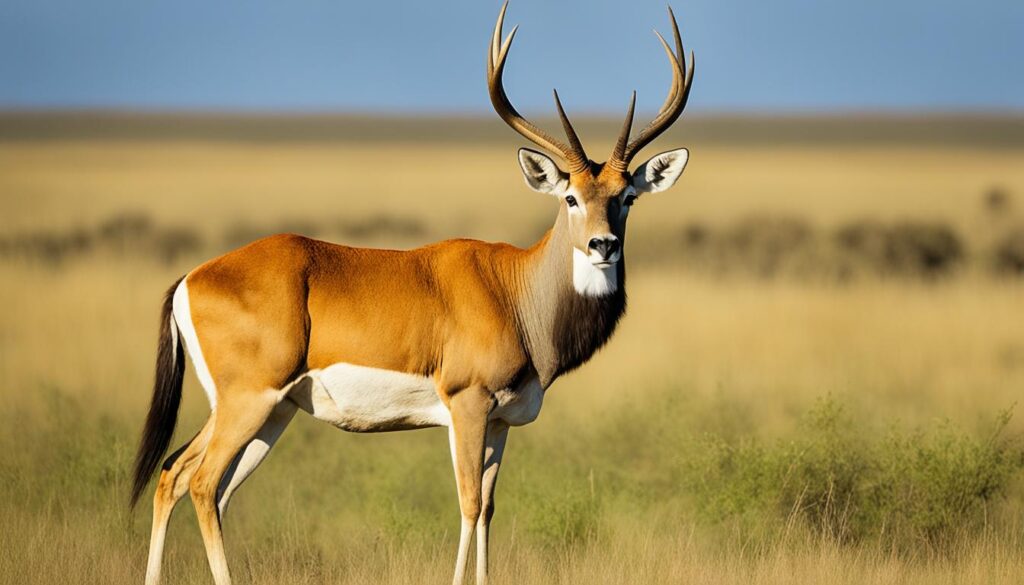
Each of these land animals, lions, leopards, and llamas, offers a glimpse into the wonders of the animal world. From the powerful presence of lions to the stealth and grace of leopards, and the gentle nature of llamas, these creatures remind us of the diversity and beauty found in nature.
Aquatic Animals That Start With L
When it comes to aquatic animals that start with L, there are some truly fascinating creatures to explore. From lobsters to lamprey fish and lion’s mane fish, the underwater world is teeming with unique species. Let’s dive in and learn more about these captivating creatures.
Lobsters
Lobsters are well-known marine creatures with a hard exoskeleton that offers them protection in their underwater habitat. These crustaceans are a favorite delicacy for many seafood enthusiasts, known for their sweet and succulent meat. Lobsters can be found in various parts of the world’s oceans, and they play a vital role in marine ecosystems.
Lamprey Fish
One of the most intriguing aquatic animals starting with L is the lamprey fish. These jawless fish have a unique feeding mechanism. They are parasitic in nature, attaching themselves to other fish and using their round mouths filled with sharp teeth to latch onto their prey. While their feeding habits may seem gruesome, lampreys play an important role in balancing aquatic ecosystems.
Lion’s Mane Fish
Another fascinating aquatic animal that starts with L is the lion’s mane fish. This large jellyfish is known for its distinctive appearance, with an orange-colored bell and long, flowing tentacles resembling a lion’s mane. Lion’s mane fish is the largest species of jellyfish in the world, which can grow to astounding sizes. They inhabit the cooler regions of the Atlantic and Pacific oceans.
Exploring these wonderful creatures gives us a glimpse into the diverse life forms that exist in our oceans. Whether it’s the hard-shelled lobsters, unique lamprey fish, or the mesmerizing lion’s mane fish, each of these aquatic animals offers its own enchanting features that make our underwater world truly remarkable.
Birds That Start With L
When it comes to birds that start with L, there are several fascinating species to explore. These birds showcase the diverse beauty and unique characteristics of avian life. Let’s take a closer look at three notable birds: the lyrebird, lark, and loon.
The lyrebird is renowned for its exceptional vocal abilities. This Australian native has an incredible repertoire of sounds and can mimic the calls of other birds and even human-made noises. Its captivating song is a testament to the lyrebird’s remarkable vocal range and adaptability.
Larks are small to medium-sized birds known for their melodious songs. These songbirds can be found in various habitats around the world. Larks are highly skilled vocalists, filling the air with their beautiful melodies. Their songs often serve as a symbol of the natural beauty and tranquility found in open fields and meadows.
Loons are large diving birds known for their distinctive calls and impressive swimming abilities. With their sleek bodies and webbed feet, they are well adapted for life on both land and water. Loons can be found in lakes and ponds, where they gracefully dive underwater in search of fish – their primary source of food.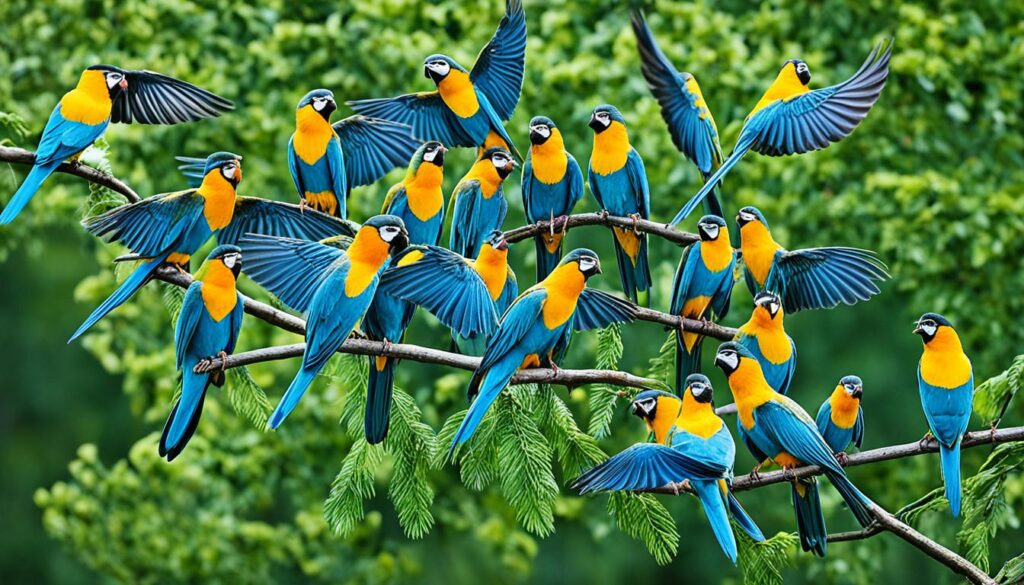
These bird species—lyrebird, lark, and loon—showcase the incredible diversity and fascinating adaptations found within avian life. Their unique songs, distinctive calls, and remarkable abilities add to the wonder and beauty of the natural world.
Reptiles That Start With L
Reptiles that start with L include lizards and leatherback turtles. These fascinating creatures exhibit unique traits and adaptations that set them apart from other reptilian species.
Lizards
Lizards are a diverse group of reptiles found in various habitats worldwide. They are known for their ability to regenerate their tails and their excellent climbing skills. Lizards come in a wide range of sizes, colors, and patterns, making them a visually captivating group of reptiles. Some common types of lizards include:
- Geckos
- Chameleons
- Anoles
- Iguanas
Each type of lizard has its own unique characteristics and adaptations that allow them to thrive in their respective environments.
Leatherback Turtles
Leatherback turtles are the largest turtles in the world and are known for their unique leathery skin and impressive diving abilities. These magnificent reptiles can grow to be over six feet long and weigh up to 2,000 pounds. Leatherback turtles have a unique feeding habit as they primarily prey on jellyfish, using their specialized jaws to consume their gelatinous prey. They are capable of diving to incredible depths in search of food, reaching depths of over 4,000 feet. Leatherback turtles are also known for their extensive migrations, traveling long distances to lay their eggs on sandy beaches.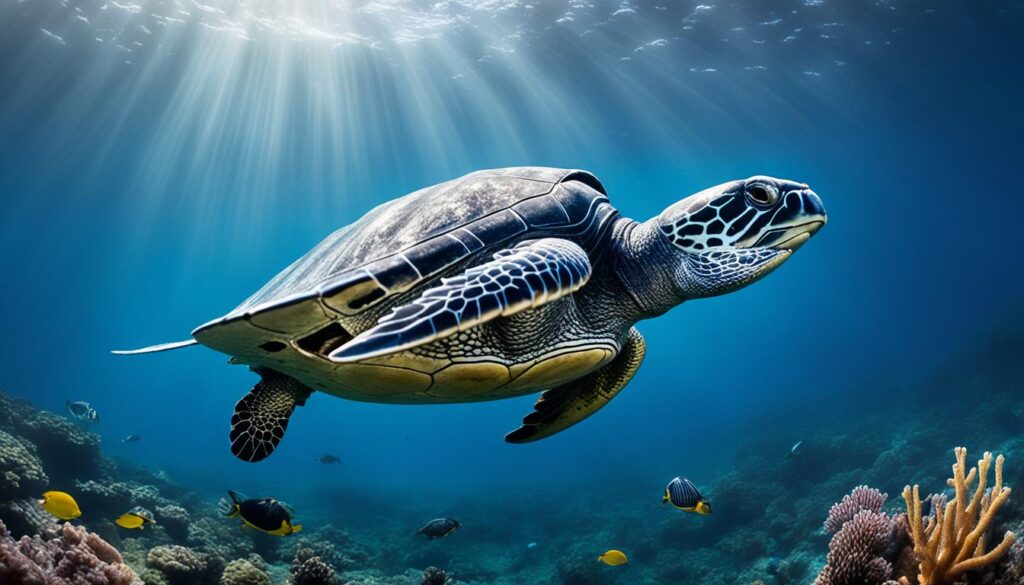
| Reptile | Characteristics |
|---|---|
| Lizards | Diverse group of reptiles found worldwide |
| Leatherback Turtles | Largest turtles, unique leathery skin, impressive diving abilities |
Exploring these reptiles not only provides insights into their incredible diversity but also highlights the importance of conservation efforts to ensure their survival in the face of various threats.
Insects That Start With L
Insects are a fascinating and diverse group of creatures, and those that start with the letter L are no exception. Among the notable insects in this category are the ladybug and the lacewing. These insects play important roles in maintaining the balance of ecosystems and are intriguing to study.
Ladybug
The ladybug, also known as ladybird or lady beetle, is a small and colorful insect that is often considered a symbol of good luck. Ladybugs are beneficial to gardens and crops because they have a voracious appetite for aphids, which are destructive pests that can harm plants. With their distinct spotted patterns and vibrant colors, ladybugs are easily recognizable and beloved by many.
“Ladybugs are not only beautiful but also incredibly helpful to gardeners. Their appetite for aphids makes them natural pest controllers.”
Lacewing
Lacewings are delicate insects characterized by their intricately patterned, lacy wings. These insects are found in various parts of the world and are known for their role in controlling pests in gardens and agricultural fields. Lacewing larvae, in particular, are voracious predators, feeding on aphids, mites, and other small insects. Their presence can greatly assist in natural pest control, reducing the need for chemical pesticides.
Lacewings are unique not only for their pest control abilities but also for their interesting reproductive behavior. Some lacewing species lay their eggs on long stalks, protecting them from predators and providing a visual spectacle in the natural world.
Studying these insects and their ecological roles allows us to appreciate the intricate and interconnected web of life in our ecosystems. Whether it’s the ladybug’s beneficial impact on gardens or the lacewing’s role in pest control, these insects demonstrate the importance of every species in maintaining a healthy and balanced environment.
| Insect | Description | Role |
|---|---|---|
| Ladybug | A small, colorful insect with distinct spots | Controls aphid populations, considered lucky |
| Lacewing | An insect with intricately patterned wings | Contributes to natural pest control in gardens |
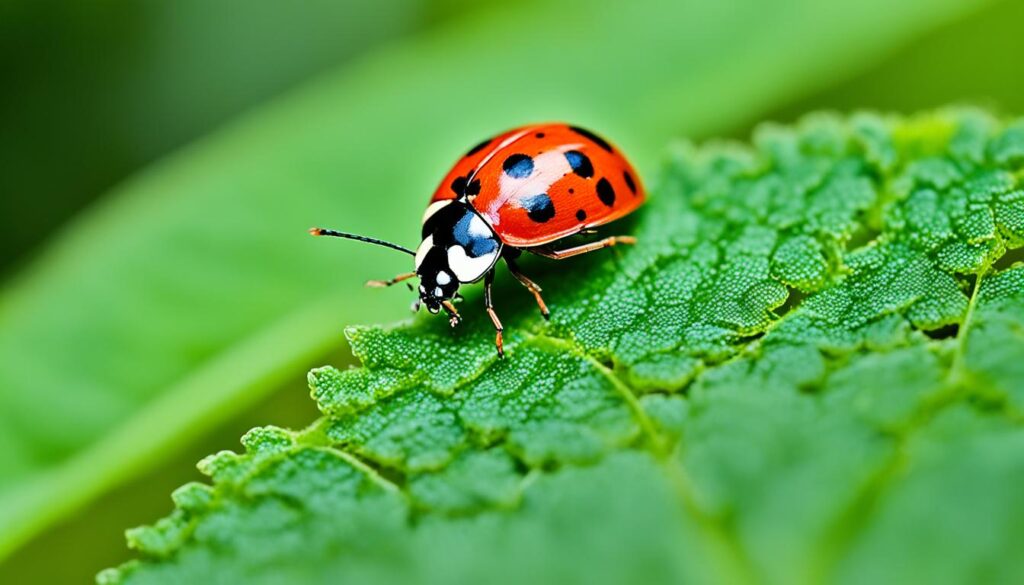
Conclusion
In conclusion, the animal kingdom is home to a diverse range of species that start with the letter L. Whether they are found on land or in water, these animals captivate us with their unique characteristics and habitats. From the majestic lions reigning over the savannah to the fascinating lobsters thriving in the depths of the ocean, each creature serves a vital role in maintaining the delicate balance of our ecosystems.
Exploring these diverse species allows us to appreciate the intricate web of life on Earth. It highlights the remarkable adaptations and survival strategies that have evolved over millions of years. From hunting prowess to unique feeding mechanisms, animals like leopards and lamprey fish showcase nature’s awe-inspiring creativity. Whether you prefer the forest or the sea, there is a vast array of animal life to be discovered.
By deepening our understanding of the natural world and its incredible diversity, we gain a greater appreciation for the fragile connections between land and water. From the soaring lyrebird melodies echoing through the Australian rainforest to the graceful lion’s mane fish drifting in the cool waters of the Atlantic, each animal contributes to the rich tapestry of life that surrounds us.FAQ
What are some well-known animals that start with L?
Why are lions often referred to as the kings of the animal kingdom?
What do lobsters primarily feed on?
What are the main characteristics of leopards?
What is unique about the song of the lyrebird?
How do lamprey fish feed?
What are some characteristics of the lion’s mane fish?
What are some lesser-known land animals that start with L?
What are some well-known animals that start with L?
What are some lesser-known animals that start with L?
What are some land animals that start with L?
What are some aquatic animals that start with L?
What are some birds that start with L?
What are some reptiles that start with L?
What are some insects that start with L?
Laura is a versatile writer and editor whose passion for animals shines through in her work. With a keen understanding of language and a love for storytelling, Laura crafts compelling narratives that captivate our audience and inspire action regarding animal welfare. Whether she’s delving into the latest research or sharing heartwarming stories of animal companionship, Laura’s work will leave a lasting impression on all who read it.
Animals
7 Animals That Look Like Hamsters
Meet various animals like hamsters such as mice, with intriguing nocturnal habits, in this list of lookalikes – discover more similarities by reading on!
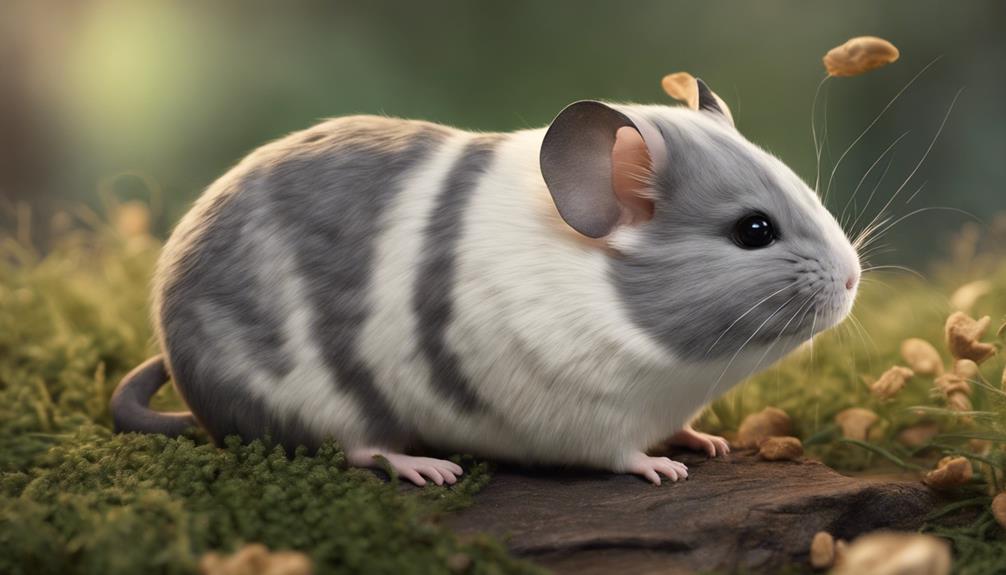
Curious about animals like hamsters? Gerbils are playful with longer lifespans. Guinea pigs, fluffy and charming, need big cages. Mice, nocturnal and small, share hamster size. Degus look like hamsters, live 5-8 years, and enjoy veggies. Chipmunks have stripes and are diurnal, primarily in North America. Prairie dogs, with complex social lives, help ecosystems. Dormice are furry with hibernation habits and forest homes. If you want to explore more lookalikes, keep on discovering!
Key Takeaways
- Gerbils: Playful hamster lookalikes with a longer lifespan of up to 5 years.
- Guinea Pigs: Fluffy hamster resemblance, charming appearance, and rewarding companionship for families.
- Mice: Small rodents similar in size to hamsters, nocturnal with peak activity at night.
- Degus: Resemble hamsters, live 5-8 years, social nature, and thrive in pairs or small groups.
- Chipmunks: Energetic hamster lookalikes with distinctive stripes, curious and lively behavior.
Gerbils: Cute Hamster Lookalikes
As a pet owner curious about animals that resemble hamsters, I find gerbils to be delightful creatures with a striking resemblance to hamsters but with some unique characteristics. Gerbils, these playful hamster lookalikes, aren't only adorable but also have a longer lifespan of up to 5 years, making them wonderful long-term companions.
One key difference is that gerbils require larger cages due to their high energy levels and playful nature. These larger enclosures provide ample space for them to run, dig, and play, enhancing their overall well-being.
The energetic behavior of gerbils, with their quick movements and powerful hind legs, adds to their playful personalities. Their active nature makes them entertaining to watch and interact with, bringing joy to any household. Despite their playful demeanor, gerbils are relatively low maintenance pets, making them suitable for pet owners of various experience levels.
Guinea Pigs: Fluffy Resemblance to Hamsters
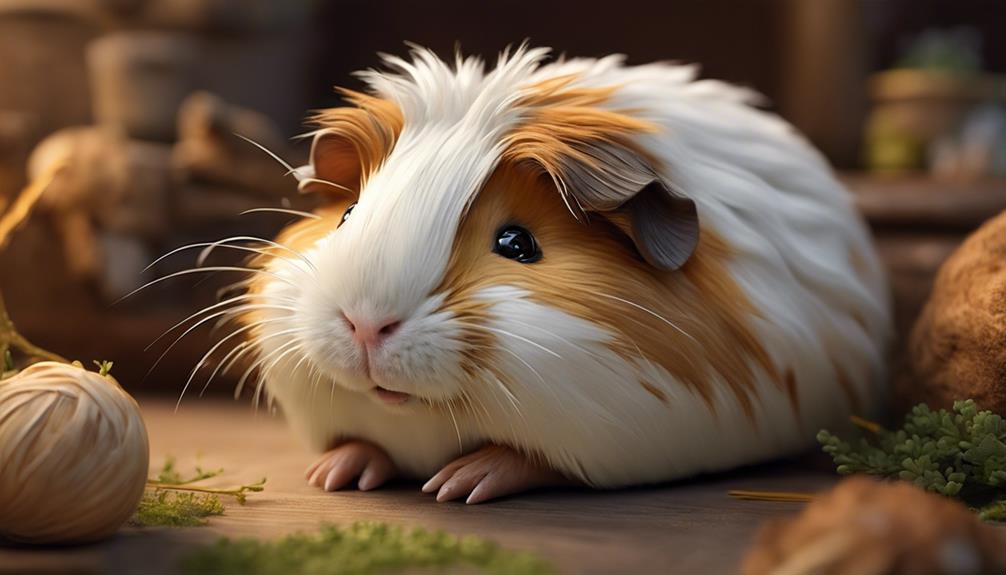
Guinea pigs, also known as cavies, share a fluffy resemblance to hamsters but have distinct differences. Their short fur coats and friendly nature make them popular pets, similar to hamsters.
Despite their similarities, guinea pigs require larger cages due to their size, showcasing their unique needs compared to their smaller hamster counterparts.
Guinea Pig Similarities
Guaranteeing their fluffy fur and charming appearance, guinea pigs bear a striking resemblance to hamsters. Both these pet rodents belong to the same family, known as the Caviidae family, which includes various species of small rodents. Guinea pigs and hamsters share similar body shapes, featuring rounded bodies and short legs that enhance their cuteness factor.
While hamsters are recognized for their cheek pouches, guinea pigs exhibit unique traits like vocalizations and social behaviors that set them apart. Providing both guinea pigs and hamsters with specific diets, habitats, and care is crucial to their well-being. Responsible ownership of these adorable animals can be incredibly rewarding for families seeking delightful companions.
Physical Resemblances
While larger in size, the fluffy resemblance between guinea pigs and hamsters enhances their appeal as charming and cuddly pets. These small animals share similarities in their physical appearance, including round bodies, cute furry faces, and a variety of colors in their coats.
Molecular phylogeny studies suggest close relationships within the rodent family, explaining why guinea pigs and hamsters exhibit such resemblances. The fluffy coat of guinea pigs mirrors the soft fur of hamsters, adding to their visual similarity.
Despite their size difference, both species possess an endearing charm that makes them popular choices for pet owners seeking adorable companions. The cuddly and adorable demeanor of guinea pigs further emphasizes their appeal, akin to that of their hamster counterparts.
Mice: Tiny Creatures Similar to Hamsters
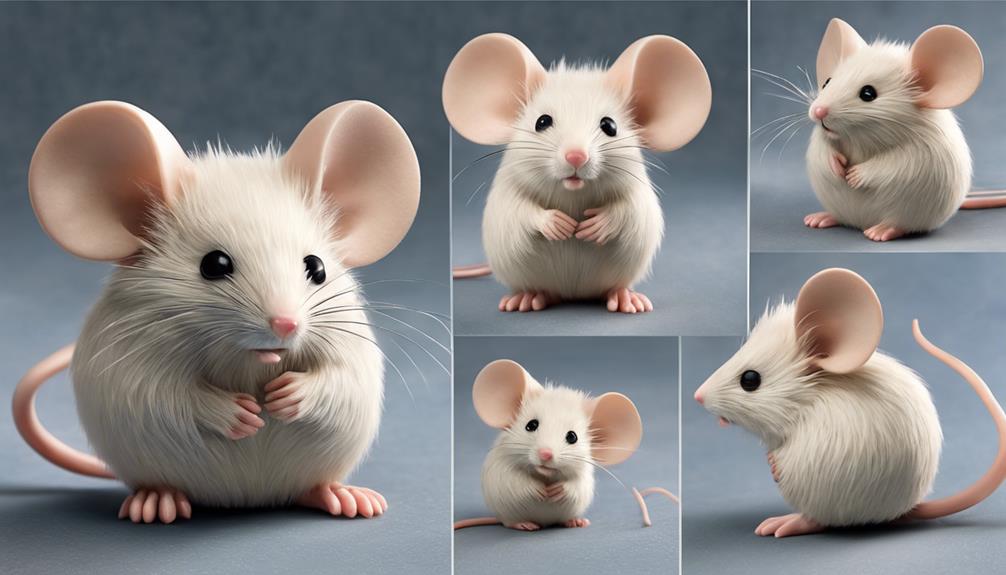
Mice, like hamsters, are small rodents that share similarities in size and appearance. They both have round bodies, pointed snouts, and fur in various colors, resembling miniature versions of each other.
However, differences exist in their behavior, diet, and care requirements, making each species unique in its own right.
Mice Vs. Hamsters
Comparing mice to hamsters reveals striking similarities in their size and behavior, making them tiny creatures that share many characteristics. Both rodents, mice and hamsters are popular pets due to their manageable size and playful nature. While mice typically measure 2.5 to 4 inches in length, similar to hamsters, they can be distinguished by their longer tails.
These small creatures have incisors that continuously grow, necessitating gnawing to prevent overgrowth. Mice exhibit remarkable agility and can squeeze through narrow openings, akin to hamsters' burrowing tendencies. Additionally, both species are nocturnal, showing peak activity levels during the night.
Whether opting for a mouse or a hamster, pet owners can enjoy the companionship and entertainment provided by these charming rodents.
Size and Habitat
In examining the size and habitat of mice, it becomes evident that these tiny creatures share striking similarities with hamsters. Mice, like hamsters, are small rodents with body lengths typically ranging from 2.5 to 3.75 inches. They're versatile in their habitats, thriving in fields, forests, and even urban settings.
Exploring their phylogenetic position and evolutionary history through molecular phylogeny reveals their close relation to other speciose mammals. Despite their resemblance to hamsters, mice have distinct characteristics and behaviors that define them as a separate species. Their agile movements and ability to navigate through small openings showcase their adaptability and resourcefulness.
Understanding the nuances of their size and habitat provides valuable insights into the diverse world of these fascinating rodents.
Behavior and Diet
As a small rodent with agile movements and quick reflexes, I share a similar diet with hamsters, consuming seeds, grains, fruits, and vegetables. Mice, being omnivores like hamsters, thrive on a varied diet that provides essential nutrients for their energy and growth.
These tiny creatures, known for their burrowing behaviors, create intricate tunnel systems similar to hamsters, using them for shelter and protection. In addition, mice exhibit social tendencies akin to hamsters, forming hierarchical structures within their groups.
These social animals engage in both cooperative and competitive behaviors, showcasing their complex social interactions. Understanding the behavior and diet of mice can offer insights into their natural tendencies and requirements for ideal care and well-being.
Degus: Lesser-Known Hamster Doppelgangers
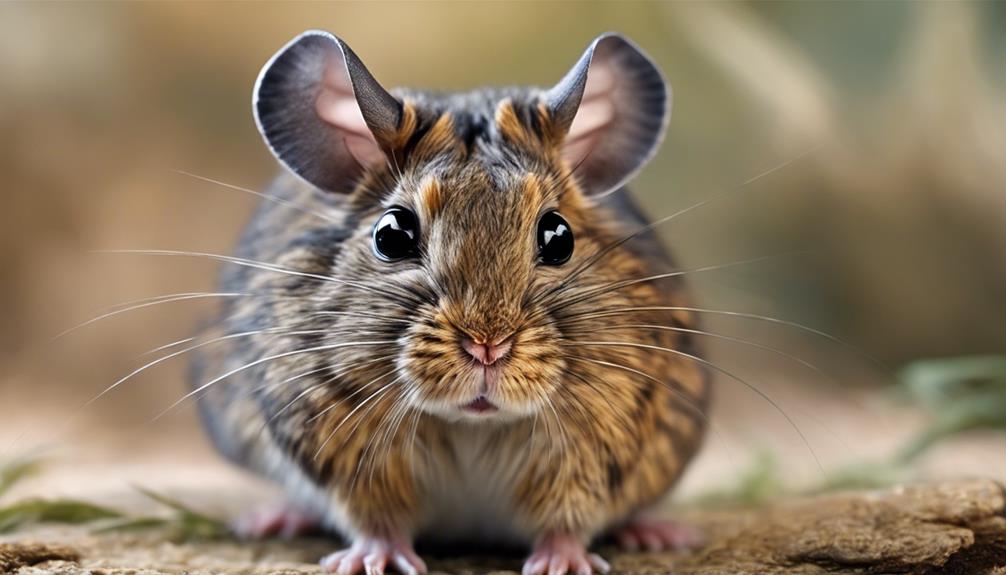
Resembling hamsters but belonging to a different species, Degus are small rodents known as Octodon degus. These social animals are native to Chile and are known for their friendly and curious nature.
Here are some key points to understand more about these fascinating creatures:
- Lifespan and Care: Degus typically live for 5-8 years in captivity. To guarantee their well-being, provide them with a spacious cage that allows for exercise and mental stimulation.
- Diet: Their diet mainly consists of hay, fresh vegetables, and a small amount of commercial rodent food. This balanced diet is essential for their nutrition and health.
- Activity Patterns: Unlike hamsters, Degus are diurnal, meaning they're most active during the day. This can impact their interaction with owners and their daily routine.
- Behavior: Due to their social nature, Degus thrive in pairs or small groups. Providing them with companionship is vital for their mental and emotional well-being.
Chipmunks: Hamster Lookalikes With Stripes
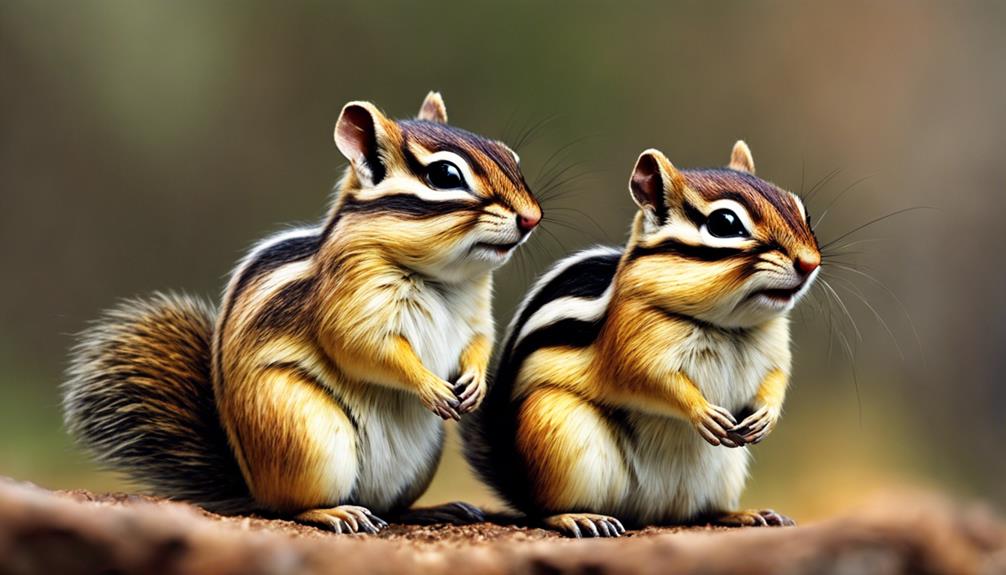
With their distinctive stripes and energetic behavior, chipmunks closely resemble hamsters but belong to a different rodent family known as Sciuridae. These small, striped rodents are easily recognizable by the contrasting stripes on their backs, adding a touch of uniqueness to their overall brown or gray fur color. One key feature that sets chipmunks apart from hamsters is their cheek pouches, which they use to store food efficiently. Chipmunks, with around 25 species primarily found in North America, are known for their curious and lively nature, making them fascinating creatures to observe.
Unlike hamsters, chipmunks are diurnal animals, meaning they're most active during the day. This behavior contrasts with hamsters, which are nocturnal and more active at night. The energetic antics and vibrant personalities of chipmunks make them a joyful addition to the rodent family. So next time you spot a small, striped rodent scurrying about, take a closer look – it might just be a chipmunk!
Prairie Dogs: Hamster-Like Burrowers
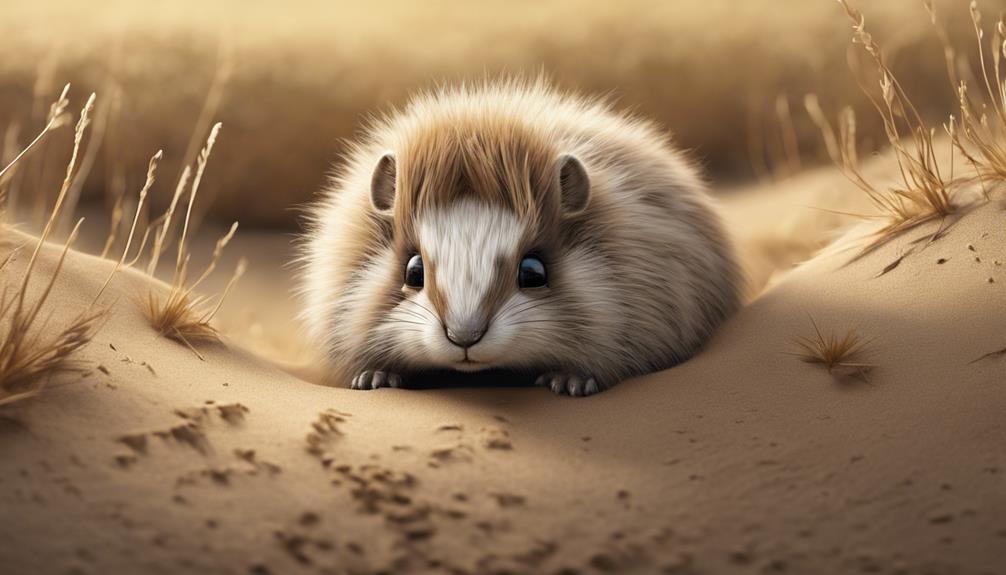
Prairie dogs, similar to hamsters in their burrowing habits, are social rodents known for their intricate underground tunnel systems. These burrowing rodents play an essential role in ecosystem maintenance, benefiting various species through their activities.
- Social Behavior: Prairie dogs exhibit complex social structures within their colonies, communicating through various vocalizations and behaviors to warn of danger and maintain cohesion.
- Burrowing Rodents: These animals are expert diggers, creating elaborate tunnel systems underground that serve as shelters, nurseries, and storage areas for food.
- Ecosystem Maintenance: Prairie dogs help aerate the soil through their digging, promoting plant growth and creating habitat for other animals like burrowing owls and snakes.
- Habitat and Distribution: Found primarily in North America's Great Plains region, prairie dogs are essential to the grasslands and prairies they inhabit, shaping the landscape and contributing to its biodiversity.
Dormice: Furry Hamster Lookalikes
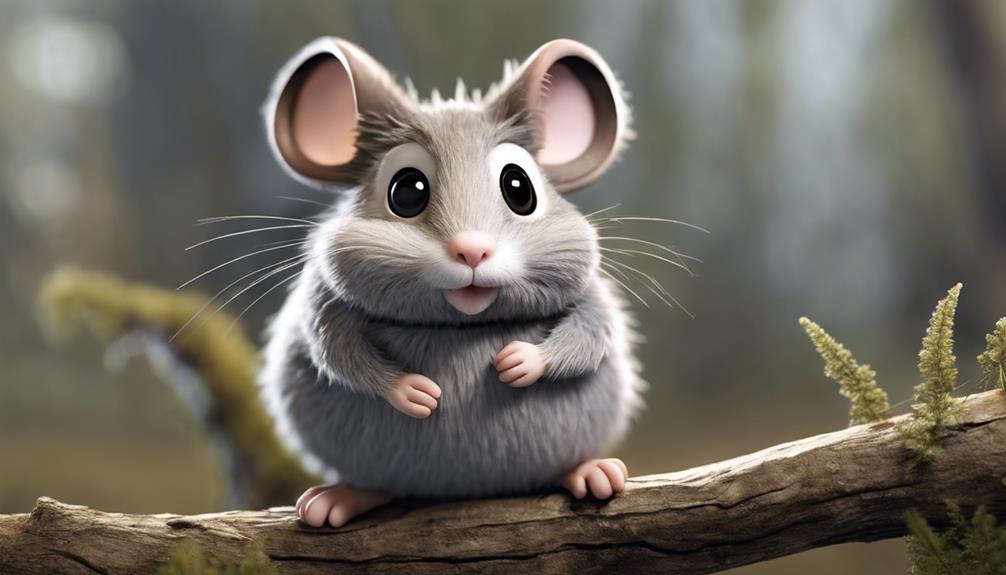
Closely resembling hamsters in appearance, Dormice are small rodents known for their furry coats and round bodies. Belonging to the family Gliridae, these creatures exhibit hibernation habits akin to some species of hamsters. With their large eyes, rounded ears, and bushy tails, dormice present a miniature version of the beloved hamster. Surprisingly, some dormice species, such as the edible dormouse, share a similar omnivorous diet with hamsters. These rodents are commonly found in Europe, Asia, and Africa, inhabiting various forested habitats reminiscent of those favored by hamsters.
Dormice's physical similarities to hamsters make them a fascinating subject for those intrigued by the adorable rodent family. Their hibernation habits add an extra layer of fascination to these creatures, showcasing their adaptability to different environmental conditions. Exploring the world of dormice can provide insight into the diverse and intriguing nature of rodents, shedding light on the unique characteristics that make them such captivating animals.
Frequently Asked Questions
What Animal Is Similar to a Hamster?
I think the animal that's similar to a hamster is the pocket gopher. It's small, round, and has cheek pouches for storing food. These creatures share similar traits with hamsters in appearance and behavior.
What Wild Animal Looks Like a Hamster?
When I spotted that wild creature, I couldn't believe my eyes! It looked just like a hamster but with a wild twist. Its furry body and round features had me captivated.
What Animal Looks Like a Rodent but Isn T?
I'll share about animals that resemble rodents but aren't. Some examples include the African pygmy hedgehog, sugar glider, tenrec, pika, and solenodon. These creatures may look like rodents, but they belong to different mammal groups.
What Is the Closest Relative to a Hamster?
The closest relative to a hamster is the common ancestor it shares with other rodents in the subfamily Cricetinae. Understanding these relationships helps in exploring their evolutionary journey and ecological adaptations within the rodent family tree.
Conclusion
To sum up, there are many animals that bear a striking resemblance to hamsters, from gerbils and guinea pigs to chipmunks and prairie dogs. These creatures may not be hamsters themselves, but they certainly share similar characteristics that make them just as adorable and fascinating to observe.
So next time you come across one of these hamster lookalikes, take a moment to appreciate the beauty and diversity of the animal kingdom. Who knows what other fascinating creatures are out there waiting to be discovered!
Dana is our Lead Content Writer, bringing a wealth of knowledge and expertise to our team. With a background deeply rooted in animal studies and a profound love for all creatures, Dana is dedicated to crafting engaging and informative content that resonates with our audience. With Dana at the helm, you can trust that our content is accurate and engaging, catering to the diverse interests of animal enthusiasts everywhere.
Animals
Discover ABC Siberian Cattery: 7 Essential Facts
Peek into the world of ABC Siberian Cattery, where premium quality Siberian forest cats await – a purrfect adventure awaits!

In 2010, ABC Siberian Cattery was established to breed quality Siberian forest cats. They maintain high breeding standards, offering hypoallergenic TICA certified cats, and even collaborated with National Geographic. Neva Masquerade, Traditional Siberian, and Color-point Siberian breeds are available, known for being hypoallergenic. Their cats undergo vet-approved care practices with regular health check-ups, vaccinations, and grooming. The adoption process includes a detailed application, personal conversations, and verification checks. ABC Siberian Cattery values customer satisfaction, provides excellent care, and plans to expand their breeding program. Discover more about ABC Siberian Cattery's exceptional standards and future developments.
Key Takeaways
- Established in 2010 with high breeding standards.
- Offers Neva Masquerade, Traditional, Color-point Siberian breeds.
- Focus on hypo-allergenic TICA certified cats.
- Emphasizes vet-approved health and care practices.
- Known for exceptional customer service and transparency.
History of ABC Siberian Cattery
Established in 2010, I founded ABC Siberian Cattery with a vision to breed high-quality Siberian forest cats. Our journey began with a deep passion for Siberian cats and a dedication to upholding the highest standards in breeding. Over the years, we've meticulously refined our techniques to produce hypo-allergenic Siberian cats that are TICA certified.
Our website uses a strict Privacy Policy to guarantee the safety of our customers' data. At ABC Siberian Cattery, we take pride in our commitment to excellence, reflected in our partnership with National Geographic for a feature on our breeding practices. Our history is a proof of our unwavering dedication to specialized breeding practices and exceptional care for our feline companions.
Breeds Available at ABC Siberian Cattery
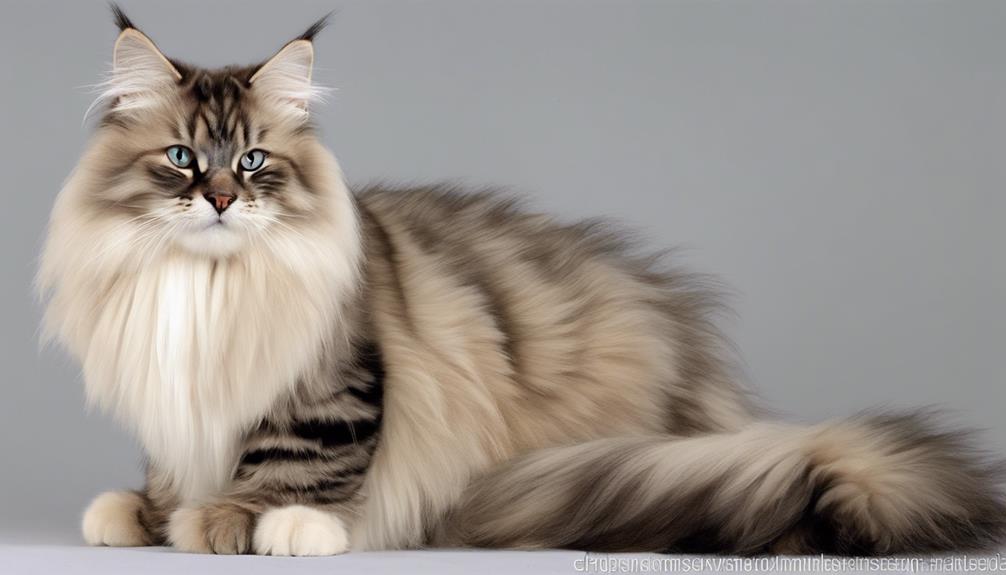
At ABC Siberian Cattery, we offer a variety of Siberian forest cat breeds for adoption. These breeds are known for their hypo-allergenic qualities, making them popular choices for families with allergies.
Visit our cattery to find the perfect Siberian forest cat breed that suits your preferences and lifestyle.
Available Breeds
Regularly, ABC Siberian Cattery introduces a variety of Siberian forest cat breeds for adoption, each meticulously raised with care and attention to guarantee their health and well-being.
| Neva Masquerade | Traditional Siberian | Color-point Siberian |
|---|---|---|
| Hypo-allergenic | Purebred | Unique color patterns |
| Blue eyes | Thick, water-repellent coat | Playful and affectionate |
These breeds at ABC Siberian Cattery offer a mix of hypo-allergenic qualities, unique coat characteristics, and distinct personalities. Whether you're drawn to the striking appearance of the Neva Masquerade, the classic beauty of the traditional Siberian, or the color variations of the color-point Siberian, each cat is thoughtfully bred to bring joy and companionship to your home.
Popular Choices
Among the popular choices available at ABC Siberian Cattery are the Neva Masquerade, Traditional Siberian, and Color-point Siberian breeds, each offering unique qualities that cater to different preferences.
The Neva Masquerade stands out with its stunning blue eyes and color-point markings, adding a touch of elegance to any household.
Traditional Siberian cats boast a thick, water-repellent coat perfect for cold climates, while their playful and affectionate nature makes them wonderful companions.
For those seeking a breed with striking color variations on their ears, paws, and tails, the Color-point Siberian is an excellent choice.
These breeds not only bring beauty but also charm and personality to your home, making them popular picks among cat enthusiasts looking for innovative and exceptional feline companions.
Health and Care Standards

At ABC Siberian Cattery, we implement vet-approved care practices and rigorous health monitoring procedures to guarantee the well-being of our Siberian forest cats.
Our commitment to maintaining high health and care standards involves regular check-ups, vaccinations, and preventative measures to keep our cats healthy and happy.
Vet-Approved Care Practices
Ensuring the health and well-being of our Siberian forest cats, ABC Siberian Cattery diligently follows vet-approved care practices. We prioritize regular veterinary check-ups, vaccinations, and preventative care for all our cats.
Proper grooming, parasite control, and dental care are also essential in maintaining peak health standards for our feline friends. At ABC Siberian Cattery, we provide a clean and safe environment with ample space for exercise and mental stimulation, promoting overall well-being.
Adhering to high care standards, we monitor our cats diligently for any signs of illness or distress, ensuring early intervention when necessary. Your cat's health is our top priority, and we're committed to providing the best care possible to keep them happy and healthy.
Health Monitoring Procedures
In our cattery, maintaining high health and care standards involves strict health monitoring procedures for all our Siberian forest cats. We conduct regular veterinary check-ups and health assessments to guarantee the well-being of our feline friends. This includes vaccinations, parasite control, and early detection of any potential health issues.
Detailed records of each cat's health history are kept, allowing us to provide necessary treatments promptly. At ABC Siberian Cattery, we prioritize preventive care and swift medical attention to uphold peak health for all our cats. By following stringent health monitoring protocols, we aim to guarantee the happiness and longevity of our beloved Siberian forest cats.
Adoption Process and Policies

I aid potential adopters through a thorough application process, interviews, and reference checks to guarantee the best match for our Siberian forest cats. When considering adopting a Siberian forest cat from ABC Siberian Cattery, here are some key points to keep in mind:
- Detailed Application Process: Our adoption process involves filling out a comprehensive application form to help us understand your lifestyle and preferences.
- Personal Conversations: We conduct discussions to make sure that both the adopter and the cat will be a good fit for each other.
- Verification Checks: References are contacted to authenticate the information provided and to ensure the well-being of our cats in their new homes.
We believe in creating lasting and fulfilling relationships between our Siberian forest cats and their new families. Our adoption policies are designed to make the process smooth and successful for both the adopters and our beloved feline friends.
Customer Testimonials and Reviews
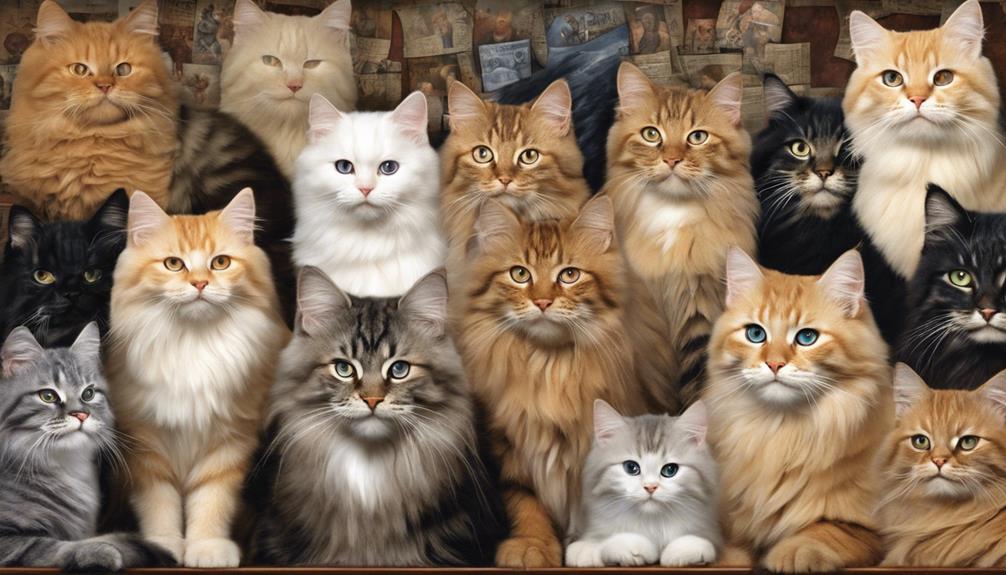
Receiving glowing testimonials and reviews, ABC Siberian Cattery stands out for its exceptional customer service and high-quality support. Customers praise the cattery for its dedication to providing excellent care for Siberian forest cats. Reviews consistently highlight the outstanding quality of the cats bred at ABC Siberian Cattery, emphasizing their health and well-being.
Testimonials frequently mention the detailed information provided during the adoption process, showcasing the cattery's commitment to transparency and education. Many customers express satisfaction with the adoption experience, underscoring ABC Siberian Cattery's reputation for excellence in every step of the process.
This positive feedback not only reflects the quality of service but also indicates a high level of customer satisfaction. ABC Siberian Cattery's consistent delivery of exceptional customer support and the premium quality of its Siberian forest cats are key factors contributing to its strong reputation in the industry.
Meet the Team at ABC Siberian Cattery

Comprised of dedicated breeders with a profound love for Siberian forest cats, the team at ABC Siberian Cattery excels in providing exceptional care and support for their feline companions.
- Our team consists of experienced breeders who are passionate about Siberian forest cats.
- We prioritize excellent care, nutrition, and socialization for all our cats.
- Each team member plays an essential role in maintaining the health, well-being, and development of our beloved cats.
At ABC Siberian Cattery, we work together seamlessly to make sure that every cat, including those from litters like Fifi's, receives individualized attention and love. Our collective expertise and unwavering commitment contribute to the high standards and exceptional quality of Siberian cats bred here. We take pride in our innovative approaches to cat care and continuously aim to set new benchmarks in the breeding industry.
Future Plans and Developments

Expanding our breeding program to introduce new bloodlines and enhance genetic diversity is a key focus for ABC Siberian Cattery's future plans and developments. By incorporating advanced health and genetic testing protocols, we aim to ensure the well-being of our future litters.
Additionally, we're diligently working on creating a more interactive online platform to provide potential adopters with the opportunity to engage with our available litters actively. Collaborations with other reputable breeders are in progress to exchange knowledge and enhance our breeding practices.
Moreover, we're exploring options to offer educational resources and guidance to new cat owners, ensuring a seamless adoption experience. Our commitment to innovation and excellence propels us to continuously improve our breeding program, providing healthy and well-adjusted Siberian cats for loving homes.
Stay tuned for exciting updates as we endeavor to elevate our standards and make a positive impact in the feline breeding community.
Frequently Asked Questions
What Are Some Fun Facts About Siberian Cats?
Siberian cats, known for their hypoallergenic coats and ancient Russian origins, display intelligence and loyalty. Their triple coat protects in cold climates. Playful and affectionate, they exhibit dog-like traits, following owners around.
How Fast Can Siberian Cats Run?
Siberian cats can sprint up to 30 miles per hour, showcasing their speed and agility. Their powerful hind legs and wild ancestry contribute to this impressive running ability. Owners should provide space for them to exercise.
What Are the Features of the Siberian Forest Cat?
The Siberian forest cat boasts a hypo-allergenic coat and a robust physique designed for harsh climates. They excel in agility, forming strong bonds with humans and pets alike. Their intelligence fuels playful exploration, making them delightful companions.
When Was the Siberian Cat Discovered?
I stumbled upon the fascinating history of Siberian cats during a late-night browsing session. It was astonishing to learn that the breed has been documented since 1000 AD, making them one of the oldest cat breeds known.
Conclusion
So there you have it, folks! ABC Siberian Cattery is the purrfect place to find your new feline friend.
With a rich history, high-quality care standards, and a team dedicated to the well-being of their cats, you can't go wrong.
Just remember, adopting a cat is a lifelong commitment, so make sure you're ready for the responsibility.
Happy cat hunting!
Dana is our Lead Content Writer, bringing a wealth of knowledge and expertise to our team. With a background deeply rooted in animal studies and a profound love for all creatures, Dana is dedicated to crafting engaging and informative content that resonates with our audience. With Dana at the helm, you can trust that our content is accurate and engaging, catering to the diverse interests of animal enthusiasts everywhere.
Animals
3 Important Facts: False
Astonishing truths about common misconceptions await in '3 Important Facts: False', challenging what you thought you knew.

Swimming after eating doesn't cause cramps, salt doesn't make water boil faster, and MSG won't give you headaches. It's important to know these facts to stay informed. Always wait before swimming after a meal, add salt for taste not speed, and MSG is safe in moderation. Check labels for hidden MSG. Remember these key details for a better understanding of common misconceptions. Explore more facts to expand your knowledge and challenge what you know. Understand the truth behind popular beliefs for a clearer perspective on the world around you. More truths await discovery in the world of myths and misconceptions.
Key Takeaways
- Milk does not increase mucus production in the body.
- Alcohol does not kill brain cells as commonly believed.
- Caffeine does not dehydrate the body contrary to popular belief.
- Napoleon was not unusually short; he was of average height for his era.
- Historical inaccuracies can distort our understanding of significant figures like Napoleon.
Common Misconceptions Debunked
Dispelling common myths and misconceptions is vital for understanding the truth behind various beliefs. It's intriguing how many false ideas people believe without questioning.
For instance, contrary to popular belief, swimming after eating doesn't cause cramps. This misconception has been debunked by scientific evidence, showing that digestion doesn't divert enough blood flow to cause cramping while swimming.
Additionally, the idea that adding salt makes water boil faster is also false. The boiling point of water remains constant regardless of salt content, as confirmed by basic chemistry principles.
Furthermore, MSG doesn't cause headaches as many people believe. Studies have shown that MSG, a flavor enhancer, doesn't trigger headaches in the majority of individuals.
It's essential to question and verify these common misconceptions to enhance our understanding of the world around us.
False Beliefs About Animals

Let's debunk some common misconceptions about animals.
From chameleons changing colors for mood and communication to birds not abandoning their babies because of human touch, there's more to animal behaviors than meets the eye.
Goldfish have memories that extend beyond a few seconds, bats aren't blind, and bulls are provoked by movement, not just the color red.
Animal Communication Myths
Many people mistakenly believe that animals change color primarily to blend in with their surroundings, but the truth is much more complex. Chameleons change their color not just for camouflage, but also to communicate with other chameleons, regulate their body temperature, and display their emotions.
Animal communication involves a variety of signals such as vocalizations, body language, scents, and visual displays. For example, dogs communicate through barks, body posture, tail wagging, and facial expressions. Birds use calls, songs, and visual displays to communicate with each other and establish territories.
Animals have intricate communication systems that include warning signals, mating calls, and social interactions. Understanding these communication methods can give us a deeper insight into the fascinating world of animal behavior.
Animal Intelligence Misconceptions
Animals, often misunderstood in their capabilities, exhibit intelligence far beyond common misconceptions. Contrary to the belief that goldfish have a mere 3-second memory, they actually possess memories that last longer.
Dogs, often thought to see only in black and white, do have color vision and can perceive a range of colors. Chameleons don't change color to blend in with surroundings; instead, they alter their hue based on mood, temperature, and communication needs.
Birds can safely digest rice without the risk of exploding, dispelling the myth. Additionally, bats, often portrayed as blind, actually have specialized adaptations for hunting in darkness. These facts show that animals possess remarkable intelligence, proving that even Einstein failed to fully grasp the extent of their cognitive abilities.
Health Myths Unveiled

Dispelling common health myths can lead to a better understanding of how our bodies function. Let's explore some fascinating facts to uncover the truth behind prevalent misconceptions. Below is a table that highlights some intriguing health myths and the actual facts that debunk them:
| Health Myth | Fact |
|---|---|
| Milk increases mucus production | Scientifically proven false |
| Alcohol kills brain cells | Debunked by research findings |
| Caffeine dehydrates the body | Incorrect when consumed in moderation |
Understanding the reality behind these myths can empower us to make informed decisions about our health. Next, we will investigate more misconceptions related to historical inaccuracies. Stay tuned for the debunking of commonly believed historical myths.
Historical Inaccuracies Exposed

Historical inaccuracies can often distort our understanding of the past. Misrepresented events, factual errors, and revisionist accounts can all contribute to these misconceptions.
It's essential to critically examine historical narratives to uncover the truth behind these inaccuracies.
Misrepresented Events
Challenging common misconceptions, historical inaccuracies regarding notable figures like Napoleon are being exposed. The belief that Napoleon was unusually short is one of these misrepresented events.
Contrary to popular belief, Napoleon was actually of average height for his time, standing at 1.68m. This misconception likely arose from historical inaccuracies and has no factual basis. In reality, his height fell within the normal range for a Frenchman of his era.
The myth of Napoleon's short stature has been perpetuated by inaccurate information over the years. By uncovering these misrepresented events, we can gain a more accurate understanding of historical figures like Napoleon and dispel long-standing myths.
Factual Errors
Revealing factual errors in historical accounts is essential for gaining a more accurate understanding of the past. To explore some misconceptions that have been lost through the head, let's examine a comparison table of popular historical inaccuracies:
| Historical Error | Truth Revealed |
|---|---|
| Napoleon had a Napoleon complex | Napoleon was actually 1.68m tall, not short-tempered |
| Three wise men were kings | They were not kings, contrary to popular belief |
| Humans coexisted with dinosaurs | Dinosaurs and humans did not live together in history |
| Benjamin Franklin discovered electricity | Electricity was not discovered through a kite experiment |
| Ninjas wore black suits | Ninjas did not typically wear black suits as shown in media |
Revisionist Accounts
Revisiting historical inaccuracies can reshape our understanding of the past, shedding light on misconceptions that have persisted over time. When it comes to the notion that abandon babies were routinely left on church doorsteps in the past, historical research reveals a more nuanced reality. While instances of abandoning infants did occur, they weren't as prevalent as previously thought.
Scientific Misunderstandings Clarified

Understanding the complexities of human sensory systems beyond the traditional five senses is essential for dispelling common misconceptions in scientific knowledge. Our ability to sense body heat is one such example. While not often considered a traditional sense, the perception of temperature is vital for maintaining homeostasis and responding to environmental changes. Our skin contains thermoreceptors that detect heat and cold, sending signals to the brain for interpretation. This sensory input helps us avoid burns, regulate body temperature, and even experience the comforting warmth of a hug.
Furthermore, our capacity to sense temperature is intertwined with other senses, such as touch and pain. The intricate network of sensory neurons allows us to distinguish between gentle warmth, intense heat, and painful burns. By understanding the multifaceted nature of our sensory systems, we can appreciate the remarkable ways our bodies perceive and interact with the world around us.
Urban Legends Debunked

Urban legends often spread misinformation and misconceptions that can be easily debunked with factual evidence and critical thinking. Let's explore the world of debunking urban legends with the help of three wise facts.
| Urban Legend Debunked | Factual Evidence | Critical Thinking |
|---|---|---|
| Great Wall from Space | Multiple man-made objects visible from space, not just the Great Wall of China | Consider the vast size of Earth and the technology used to view it from space |
| Glass as Slow Liquid | Glass is an amorphous solid with a disordered atomic structure | Examine the scientific properties of glass and how it differs from liquids |
| Mother Birds Abandoning | Mother birds do not abandon their babies if touched by humans | Understand the natural instincts of birds and how they care for their young |
| Taste Bud Distribution | Taste buds are distributed evenly across the tongue | Experiment with different tastes on various parts of the tongue |
| Ancient Spherical Earth | Ancient civilizations, like the Greeks, knew the Earth was spherical | Research historical evidence and scientific knowledge from ancient times |
Mythbusting in Popular Culture

After exploring urban legends debunked, the focus now shifts to mythbusting in popular culture, shedding light on common misconceptions and truths in society. Popular TV shows like 'MythBusters' have played a significant role in bringing mythbusting into mainstream entertainment. These shows entertain while simultaneously educating viewers on the importance of separating fact from fiction.
Social media platforms and websites also contribute to spreading awareness about myths and truths, fostering a culture of critical thinking. By engaging in mythbusting activities, individuals of all ages can't only enjoy the process but also enhance their understanding of the world around them. It's vital to remember that mythbusting serves a dual purpose – not only does it entertain, but it also helps combat the spread of misinformation.
Embracing the principles of mythbusting can empower individuals to question what they hear and see, ultimately leading to a more informed and discerning society.
Debunked Everyday Myths
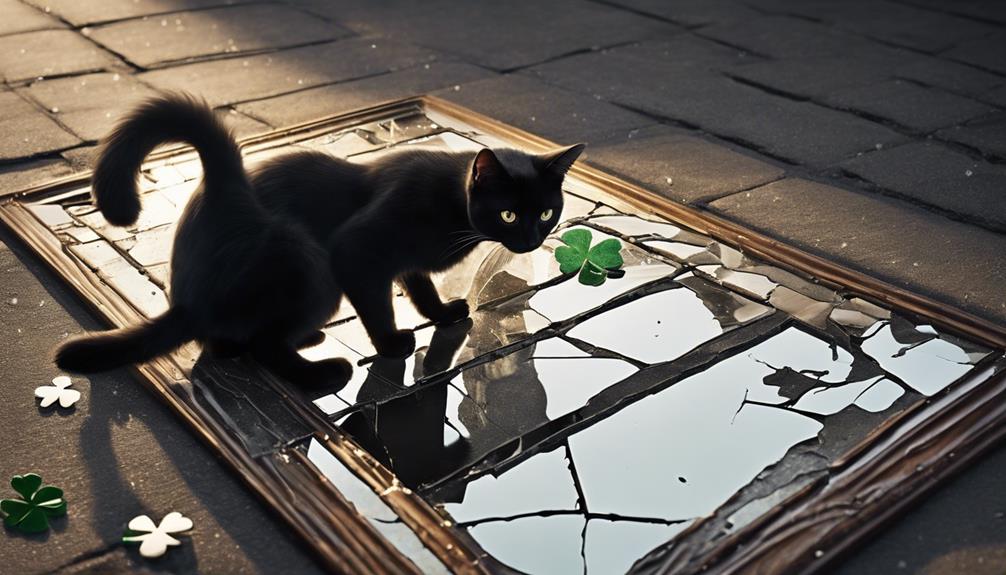
Swimming after eating doesn't cause cramps, contrary to popular belief; debunked everyday myths shed light on common misconceptions in society.
Let's explore another fascinating myth: the notion of left and right brain dominance. In the past, it was widely believed that individuals were either left-brained, analytical, and logical, or right-brained, creative, and intuitive. However, recent research has debunked this myth, revealing that both hemispheres of the brain work together in harmony for most tasks.
While certain functions may be more lateralized to one side, such as language processing being more dominant in the left hemisphere for most people, the idea of being distinctly left or right-brained is oversimplified. Our brains are incredibly complex, with intricate networks connecting various regions to perform tasks.
Understanding the true nature of brain function can help us appreciate the brain's versatility and adaptability, debunking the outdated myth of left and right brain dominance.
Frequently Asked Questions
Can a Fact Be Proven False?
Indeed, facts can be proven false. Evidence, research, and verified sources debunk inaccurate information. Critical thinking is vital to discern truth. Updating beliefs based on new evidence guarantees accuracy. It is imperative to challenge and verify information.
What Is an Example of a Myth and a Fact?
In cooking, a myth is that salt speeds up water boiling; in reality, it's a misconception. An example of a fact is that both sides of the brain can learn various skills, debunking the idea of strict divisions.
Did You Know Weird Facts?
Yes, I'm well-versed in weird facts! Birds using Xbox controllers and otters tricking birds with fish scales are fascinating examples. Learning about animals like owls, cats, and snakes always keeps me intrigued.
What Are Random Facts About Me?
I enjoy embracing heights of flavor in diverse cuisines, yet tremble at the thought of literal heights. My love for reading takes me on fantastical journeys, while Luna, my playful feline, keeps me grounded.
Conclusion
To sum up, remember to always question and investigate information before accepting it as true. By debunking common misconceptions and myths, we can expand our knowledge and understanding of the world around us.
Stay skeptical, seek out reliable sources, and don't be afraid to challenge popular beliefs. Keep learning and growing, and you'll be able to separate fact from fiction with ease.
Dana is our Lead Content Writer, bringing a wealth of knowledge and expertise to our team. With a background deeply rooted in animal studies and a profound love for all creatures, Dana is dedicated to crafting engaging and informative content that resonates with our audience. With Dana at the helm, you can trust that our content is accurate and engaging, catering to the diverse interests of animal enthusiasts everywhere.
-

 Vetted2 months ago
Vetted2 months ago15 Best Cat Foods for Managing Hyperthyroidism – Vet Approved and Feline Friendly
-
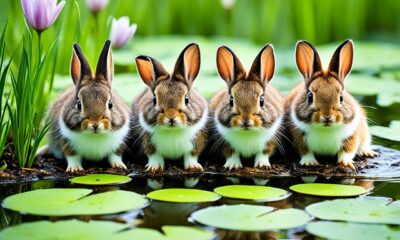
 Animal Facts2 months ago
Animal Facts2 months agoSpring Animals: A Guide to Seasonal Wildlife
-

 Cats7 months ago
Cats7 months agoTop 5 Cat Breeders in Arkansas: A Guide
-
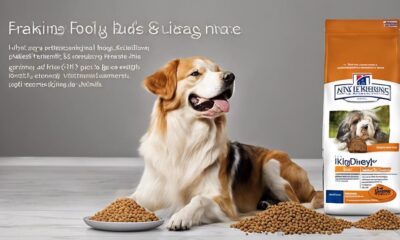
 Vetted1 month ago
Vetted1 month ago15 Best Dog Foods for Kidney Disease – Expert Recommendations for Your Pet's Health
-

 Vetted2 months ago
Vetted2 months ago15 Best Fresh Dog Food Delivery Services for Your Pup's Health and Happiness
-

 Rabbits2 months ago
Rabbits2 months agoExploring Rabbit Holes: What Do They Look Like?
-

 Pets2 months ago
Pets2 months agoLatest Pet Statistics in US – Trends & Insights in 2024
-
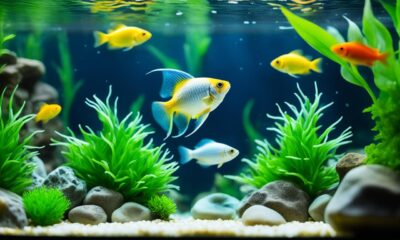
 Fish2 months ago
Fish2 months agoKeeping Your Sucker Fish Thriving at Home






















